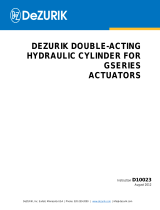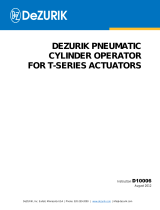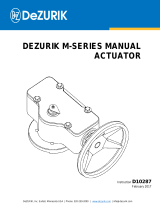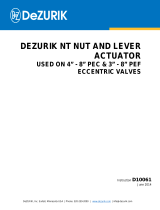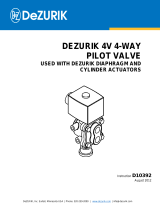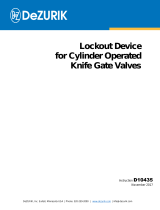Page is loading ...

DeZURIK, Inc. Sartell, Minnesota USA | Phone: 320-259-2000 | www.dezurik.com | [email protected]
DEZURIK R1 AND R2
POWERRAC® ACTUATORS
Instruction D10268
February 2022

DeZURIK
Instruction and Operating Manual Page 2 © 2022 DeZURIK, Inc.
Instructions
These instructions are for use by personnel who are responsible for the installation, operation and
maintenance of DeZURIK valves, actuators or accessories.
Safety Messages
All safety messages in the instructions are identified by a general warning sign and the signal word CAUTION,
WARNING or DANGER. These messages indicate procedures to avoid injury or death.
Safety label(s) on the product indicate hazards that can cause injury or death. If a safety label becomes difficult
to see or read, or if a label has been removed, please contact DeZURIK for replacement label(s).
Personnel involved in the installation or maintenance of valves should be constantly alert to potential
emission of pipeline material and take appropriate safety precautions. Always wear suitable protection
when dealing with hazardous pipeline materials. Handle valves which have been removed from service
with suitable protection for any potential pipeline material in the valve.
Inspection
Your DeZURIK product has been packaged to provide protection during shipment; however, items can be
damaged in transport. Carefully inspect the unit for damage upon arrival and file a claim with the carrier if
damage is apparent.
Parts
Replaceable wear parts are listed on the assembly drawing. These parts can be stocked to minimize
downtime. Order parts from your local DeZURIK sales representative or directly from DeZURIK. When ordering
parts please provide the following information:
If the valve has a data plate: please include the 7-digit part number with either 4-digit revision number
(example: 9999999R000) or 8-digit serial number (example: S1900001) whichever is applicable. The
data plate will be attached to the valve assembly. Also, include the part name, the assembly drawing
number, the balloon number and the quantity stated on the assembly drawing.
If there isn't any data plate visible on the valve: please include valve model number, part name, and
item number from the assembly drawing. You may contact your local DeZURIK Representative to help
you identify your valve.
DeZURIK Service
DeZURIK service personnel are available to maintain and repair all DeZURIK products. DeZURIK also offers
customized training programs and consultation services. For more information, contact your local DeZURIK
sales representative or visit our website at DeZURIK.com.

DeZURIK
R1 and R2 POWERRAC® Actuators
February 2022 Page 3 D10268
Table of Contents
Description ................................................................................................................................. 4
Installation .................................................................................................................................. 4
Operation ................................................................................................................................... 5
Lubrication ................................................................................................................................. 6
Position Stops ............................................................................................................................ 7
Removing Actuator .................................................................................................................... 8
Actuator Disassembly ................................................................................................................ 8
Double-Acting Cylinder Disassembly ....................................................................................... 10
Spring-Return Cylinder Disassembly ....................................................................................... 11
Spring-Return Cylinder Reassembly ........................................................................................ 12
Double-Acting Cylinder Reassembly ........................................................................................ 13
Double-Acting Actuator Reassembly ....................................................................................... 14
Spring-Return Actuator Reassembly ........................................................................................ 18
Mounting Actuator .................................................................................................................... 20
Changing from Double-Acting to Spring-Return Spring-to-Close ............................................ 22
Changing from Double-Acting to Spring-Return Spring-to-Open ............................................ 22
Changing from Spring-Return Spring-to-Close to Double-Acting ............................................ 24
Changing from Spring-Return Spring-to-Open to Double-Acting ............................................ 24
Reversing Spring Action .......................................................................................................... 24
Changing Mounting Position .................................................................................................... 24
Lockable Model ........................................................................................................................ 25
Unlocked Condition .............................................................................................................. 25
Locked Closed Position ........................................................................................................ 25
Locked Open Position .......................................................................................................... 26
Troubleshooting ....................................................................................................................... 28

DeZURIK
R1 and R2 POWERRAC® Actuators
February 2022 Page 4 D10268
Description
The DeZURIK R1 and R2 PowerRac® actuators are quarter-turn, enclosed rack and gear cylinder actuators.
The R1 and R2 PowerRac® actuator are used for on-off or modulating control on valves that have a square
shaft connection.
The R number designates the radius of the actuator gear. A choice of cylinder diameters is offered—4 and 6"
(100 mm and 150 mm) on the R1 actuator, and 6 and 8" (150 mm and 200 mm) on the R2 actuator.
The R1 and R2 PowerRac® actuator is available as a double-acting actuator or as a spring-return actuator,
either spring-to-open or spring-to-close. The spring action may be reversed by ordering the alternate spring-
return cylinder assembly, and exchanging the positions of the two cylinders. The cylinder mounting interface is
the same for all PowerRac® actuators.
A lockable model of The DeZURIK PowerRac® actuator is also available. Operation of the lockable model is
described on page 19.
These instructions include information for all three actuator configurations, and for changing from one to
another. See Figure 1 to identify the applicable configuration; refer to Figures 2 through 4 to identify the
components within each configuration.
Installation
Pneumatic connections are required as shown in Figure 1, and as described below. All cylinder port
connections are ¼" NPT.
Double-Acting Actuator
The double-acting actuator requires two pneumatic connections—one to each port on opposite ends of the
cylinder. Air to the connection closest to the actuator drives the actuator clockwise, towards the “shut” position
on the dial; air to the connection farthest from the actuator drives the actuator counterclockwise, towards the
“open” position on the dial.
Spring-Return Actuator
The spring-return actuator requires one pneumatic connection—to the fitting on the tubing that connects the
two cylinders. With a spring-to-open spring cartridge, air to the connection drives the actuator clockwise,
towards the “shut” position on the dial; with a spring-to-close spring cartridge, air to the connection drives the
actuator counterclockwise, towards the “open” position on the dial.
As the spring-return actuator is cycled, air is alternately exhausted and drawn in through two breathers—one
on each cylinder as shown in Figure 1. The breathers must be protected from water because water inside of
the actuator will cause sticking and premature wear of the internal components. If the actuator is located
outdoors or in an area that will be hosed down, the breathers must be oriented vertically. The “umbrella” top of
the breathers will then prevent water from being drawn in through the breathers. In locations that are
submerged or subject to flooding, the breathers must be removed and remotely piped to a protected location.

DeZURIK
R1 and R2 POWERRAC® Actuators
February 2022 Page 5 D10268
Installation (continued)
Figure 1—R1 and R2 PowerRac® Configurations
Operation
The R1 and R2 PowerRac® actuator is powered pneumatically, and rotates 90° between the open and closed
positions, in the direction as described above.
The double-acting cylinder is sized for 60 psi or 80 psi (415 kPa or 550 kPa), and the spring-return cylinder is
sized for a 60 psi (415 kPa) spring only.
All cylinders are limited to 100 psi (690 kPa) maximum.

DeZURIK
R1 and R2 POWERRAC® Actuators
February 2022 Page 6 D10268
Lubrication
The actuator has been lubricated at the factory and requires no routine lubrication. If the actuator is
disassembled (see Figures 2 thru 4 for actuator parts identification);
apply a paint-like coating using one of these lubricants:
- Dow Corning Molykote No. 44 (recommended)
- Shell Retinax AM (alternate)
- Shell Lithall MDS (alternate)
to the following surfaces:
• Inside diameter of cylinder tube (C6 or S6)
• Chamfer for cylinder tube on cylinder cap (C11 or S11) and cylinder head of housing (C1 or S1)
• O-rings (C5 or S5, C8 or S8, and C14 or S14) and grooves
• Seals (C3 or S3 and C9 or S9) and grooves
• Thread seal (C16 or S16)
• Inside diameter of bearing (C2 or S2) located in cylinder head housing.
• Outside diameter of piston rod (C4 or S4).
• Top cover O-ring (B10) and groove in top cover (B11), before assembly
apply a paint-like coating using one of these lubricants:
- Keystone Zeniplex-1 (recommended)
- Amoco Amolith Grease #1-EP (alternate)
- Amsoil GHD (alternate)
- Mobil Mobilux EP 1 (alternate)
- Petro-Canada Vultrex MPG EP 1 (alternate)
- Shell Alvania EP 1 (alternate)
- Texaco Multifak EP 1 (alternate)
to the following surfaces:
• Flat side of rack bearing (B3), before assembly
• Back side of rack (B5) that contacts rack bearing, before assembly
• Both bearing hubs of gear (B8), before assembly
• Teeth in rack (B5) and gear (B8) after assembly (so witness marks are visible during assembly).
• Both inside and outside flat surfaces of the collet wedges (surfaces that contact the valve shaft and the
inside of the gear) and the mating surfaces on the inside of the gear.

DeZURIK
R1 and R2 POWERRAC® Actuators
February 2022 Page 7 D10268
Position Stops
The adjustable open and closed position stops prevent the actuator from rotating beyond the open and closed
positions of the valve.
Double Acting Actuator
The closed position stop is located in the cylinder cap, and the open position stop is located in the actuator end
cover.
Spring-Return Actuators
With a spring-to-open spring cartridge, the closed position stop is located in the spring cylinder (the longer
cylinder), and the open position stop is located in the other (shorter) cylinder.
With a spring-to-close spring cartridge, the open position stop is located in the spring cylinder (the longer
cylinder), and the closed position stop is located in the other (shorter) cylinder.
Adjustments
If the actuator is factory-mounted on the valve, the stops are preset, and do not require further adjustment. If
the actuator is not factory-mounted on the valve, or if the actuator is removed and/or disassembled, the stops
will require adjustment as described below. Refer to the Valve Instructions for closed-position information, and
adjust the stops after the actuator is mounted on the valve.
The adjustable stops are square head screws, secured with jam nuts, and located in the extreme ends of the
actuator as shown in Figures 1 through 4.
To adjust either stop:
1. Loosen the jam nut, and turn the screw counterclockwise to increase the stroke, or clockwise to
decrease the stroke.
2. After the stop is adjusted to the desired position, hold the screw from turning, and tighten the jam nut to
the torque value shown in Table A.
Jam Nut
Carbon Steel
Stainless Steel
Foot Pounds
Newton Meters
Foot Pounds
Newton Meters
1/2” Nut on 4”
Cylinder Cap
63 ± 8
85 ± 11
38 ± 5
52 ± 7
5/8” Nut on 6”
Cylinder Cap
130 ± 20
176 ± 27
77 ± 10
104 ± 14
3/4” Nut on 8”
Cylinder Cap
230 ± 30
312 ± 41
140 ± 18
190 ± 24
5/8” Nut on End
Cover
130 ± 20
176 ± 27
77 ± 10
104 ± 14

DeZURIK
R1 and R2 POWERRAC® Actuators
February 2022 Page 8 D10268
Removing Actuator
Refer to Figure 2 for component identification.
Flow in the pipeline with the actuator removed can allow the valve to slam closed and
cause personal injury and/or damage to the flow system. Shut down the flow in the
pipeline before removing the actuator from the valve.
1. Shut down the flow in the pipeline.
Moving parts from unexpected operation of a powered actuator can cause personal
injury or equipment damage. Disconnect and lock out power to the actuator before
servicing.
2. Disconnect and lockout the pneumatic power to the actuator to prevent accidental operation of the
actuator.
3. Release the collet assembly (B9) from the valve shaft by loosening the jam nut (B9D) and the hex
socket set screw (B9A) that extends through the pointer (B9F) on top of the actuator.
4. Remove the four mounting screws (B26) that fasten the actuator to the valve.
5. Remove the actuator from the valve by lifting the actuator from the valve shaft.
Actuator Disassembly
Refer to Figures 2, 3 and 4 for component identification.
1. Remove the four pointer screws (B9G), and remove the collet assembly (B9), together with the pointer
(B9F) from the actuator.
2. Remove the four top cover screws (B15) and remove the top cover (B11).
3. Remove the top cover gasket (B13) and the O-ring (B10).
4. Remove the gear (B8).
5. Remove the four cylinder assembly nuts (B20) and lockwashers (B19), and remove the cylinder
assembly (C00) and gasket (B16).
6. Remove the rack screw (B7), the lockwasher (B6), and separate the rack (B5) from the piston rod (C4).
7. Remove the rack bearing (B3) from the pin (B4).
8. If the actuator is double-acting, remove the four end cover nuts (B20) the lockwashers (B19), the end
cover (B17) and gasket (B16).
9. If the actuator is spring-return, remove the four cylinder assembly nuts (B20) lockwashers (B19), the
spring-return cylinder assembly (S00) and the gasket (B16).

DeZURIK
R1 and R2 POWERRAC® Actuators
February 2022 Page 9 D10268
Actuator Disassembly (continued)
Figure 2—Actuator Assembly, Less Cylinders

DeZURIK
R1 and R2 POWERRAC® Actuators
February 2022 Page 10 D10268
Double-Acting Cylinder Disassembly
Refer to Figure 3 for component identification.
1. Remove the tie rod nuts (C15) and washers (C13) from the tie rods (C12).
2. Remove the cylinder cap (C11).
3. Push the piston rod (C4) through the cylinder head (C1), and remove the piston (C7) and piston rod
(C4).
4. Remove the piston nut (C10), the piston (C7), and the O-ring (C14) from the piston rod (C4).
5. Remove the cylinder tube (C6) from the cylinder head (C1).
6. Remove the piston seal (C9) and the O-ring (C8) from the piston (C7).
7. Remove the piston rod seal (C3) from the cylinder head (C1).
8. Remove the two cylinder tube O-rings (C5) from the cylinder head (C1) and from the cylinder cap
(C11).
Figure 3—Double-Acting Cylinder Assembly

DeZURIK
R1 and R2 POWERRAC® Actuators
February 2022 Page 11 D10268
Spring-Return Cylinder Disassembly
Refer to Figure 4 for component identification.
The spring assembly (S19) contains a compressed spring that can cause death or
personal injury if the cylinder tie rod nuts are removed while the spring force is on the
tie rod nuts. DO NOT REMOVE THE CYLINDER TIE ROD NUTS UNLESS THE SPRING
FORCE DECREASES TO ZERO!
1. Loosen the tie rod nuts (S15) on the tie rods (S12).
Note: Force from the spring assembly will be felt during the first few turns of the nuts. As the cylinder tie rod
nuts are loosened, the force from the spring assembly must decrease to zero before the nuts can be removed
from the tie rods. The nuts and washers (S13) may be removed safely after the force from the spring assembly
decreases to zero. If the spring force does not decrease to zero, re-tighten the nuts and contact the factory.
2. Remove the cylinder cap (S11).
3. Push the piston rod (S4) through the cylinder head (S1) so that the spring assembly (S19) is
accessible.
The spring assembly (S19) contains a compressed spring that can cause death or
personal injury if the assembly is taken apart. DO NOT DISASSEMBLE THE SPRING
ASSEMBLY!
4. Remove the spring assembly (S19) carefully from the cylinder tube (S6).
Note: Do not damage the cylinder wall with the spring assembly during this step. Do not disassemble the
spring assembly!
5. Remove the cylinder tube (S6), the piston (S7) and the piston rod (S4) from the cylinder head (S1).
6. Remove the piston (S7) and the piston rod (S4) from the cylinder tube (S6).
7. Remove the piston nut (S10), the piston (S7) and the O-ring (S14) from the piston rod (S4).
8. Remove the piston seal (S9) and the O-ring (S8) from the piston (S7).
9. Remove the piston rod seal (S3) from the cylinder head (S1).
10. Remove the two cylinder tube O-rings (S5) from the cylinder head (S1) and from the cylinder cap (S11).

DeZURIK
R1 and R2 POWERRAC® Actuators
February 2022 Page 12 D10268
Spring-Return Cylinder Reassembly
Clean and inspect all parts before reassembly. Refer to Figure 4 for component identification. See Figure 1 for
orientation of cylinder assembly and end cover on spring-to-open and spring-to-close actuator configurations.
See “Lubrication” section for lubricating requirements.
Figure 4—Cylinder Assembly
1. Replace worn parts, especially sealing components such as O-rings, other seals, and the cylinder tube.
2. Lubricate O-rings, other seals, and the cylinder tube walls.
3. With the O-ring and groove toward the piston rod, place the O-ring (S14), the piston (S7), and the nut
(S10) on the piston rod (S4).

DeZURIK
R1 and R2 POWERRAC® Actuators
February 2022 Page 13 D10268
Spring-Return Cylinder Reassembly (continued)
4. Tighten the nut to 45 ± 5 foot pounds (61 ± 7 Nm).
5. Place the O-ring (S8) in the smaller groove of the piston (S7). Place the piston seal (S9) in the larger
groove of the piston as far around the circumference as possible without stretching the seal. Angle the
remaining portion of the seal, and carefully slip it over the edge of the piston and into the groove.
6. Place the piston rod seal (S3) in the cylinder head (S1).
7. Push the piston rod (S4) through the cylinder head (S1) so that the piston (S7) is against the cylinder
head.
8. Place the two cylinder tube O-rings (S5) in the groove in the cylinder head (S1) and in the groove in the
cylinder cap (S11).
9. Using care to avoid damage to the piston seal (S9), replace the cylinder tube following the appropriate
steps for the size:
a. If the cylinder tube (S6) diameter is 6 or 8" (150 mm), place the cylinder tube over the piston
(S7) at about a 45° angle. Carefully square the cylinder tube into alignment with the piston, and
push the cylinder tube into position on the cylinder head (S1).
b. If the cylinder tube diameter is 4" (100 mm), push the cylinder tube on straight, without the
angle.
10. Note the end of the spring assembly (S19) that has a 1 1/8" (29 mm) diameter machined hole. With the
hole toward the piston (S7), carefully insert the spring assembly into the cylinder tube (S6) so that the
hole fits over the piston nut (S10). Do not damage the cylinder wall with the spring assembly during
this step.
11. Align the holes in the cylinder cap (S11) with the tie rods (S12) and insert the cylinder cap into the
cylinder tube (S6). Place the tie rod nuts (S15) and washers (S13) on the tie rods. If the cylinder tube
diameter is 4" (100 mm), tighten the nuts (5/16") to 12 ± 2 foot pounds (16 ± 3 Nm); if the cylinder tube
diameter is 6" (150 mm), tighten the nuts (1/2") to 16 ± 2 foot pounds (22 ± 3 Nm).
Double-Acting Cylinder Reassembly
Clean and inspect all parts before reassembly. Refer to Figure 3 for component identification. See
“Lubrication” section for lubricating requirements.
1. Replace worn parts, especially sealing components such as O-rings, other seals, and the cylinder tube.
2. Lubricate O-rings, other seals, and the cylinder tube walls.
3. With the O-ring and groove toward the piston rod, place the O-ring (S14), the piston (S7), and the nut
(S10) on the piston rod (S4).
4. Tighten the nut to 45 ± 5 foot pounds (61 ± 7 Nm).
5. Place the O-ring (S8) in the smaller groove of the piston (S7). Place the piston seal (S9) in the larger
groove of the piston as far around the circumference as possible without stretching the seal. Angle the
remaining portion of the seal, and carefully slip it over the edge of the piston and into the groove.

DeZURIK
R1 and R2 POWERRAC® Actuators
February 2022 Page 14 D10268
Double-Acting Cylinder Reassembly (continued)
6. Place the piston rod seal (S3) in the cylinder head (S1).
7. Push the piston rod (S4) through the cylinder head (S1) so that the piston (S7) is against the cylinder
head.
8. Place the two cylinder tube O-rings (S5) in the groove in the cylinder head (S1) and in the groove in the
cylinder cap (S11).
9. Using care to avoid damage to the piston seal (S9), replace the cylinder tube following the appropriate
steps for the size:
a. If the cylinder tube (S6) diameter is 6 or 8" (150 mm), place the cylinder tube over the piston
(S7) at about a 45° angle. Carefully square the cylinder tube into alignment with the piston, and
push the cylinder tube into position on the cylinder head (S1).
b. If the cylinder tube diameter is 4" (100 mm), push the cylinder tube on straight, without the
angle.
10. Align the holes in the cylinder cap (S11) with the tie rods (S12) and insert the cylinder cap into the
cylinder tube (S6). Place the tie rod nuts (S15) and washers (S13) on the tie rods. If the cylinder tube
diameter is 4" (100 mm), tighten the nuts (5/16") to 12 ± 2 foot pounds (16 ± 3 Nm); if the cylinder tube
diameter is 6" (150 mm), tighten the nuts (1/2") to 16 ± 2 foot pounds (22 ± 3 Nm).
Double-Acting Actuator Reassembly
Clean and inspect all parts before reassembly. Refer to Figure 3 for component identification. See
“Lubrication” section for lubricating requirements.
1. Replace worn parts, especially sealing components such as O-rings and gaskets.
2. Lubricate the following surfaces:
• The flat side of the rack bearing (B3)
• Both bearing hubs of the gear (B8)
• The top cover O-ring (B10) and the groove in the top cover (B11)
• Both sides of the four wedges in the collet assembly (B9), and the mating four surfaces inside of the
gear (B8).
• The teeth in the rack (B5) and in the gear (B8)
3. Place the rack bearing (B3) on the pin (B4).
Note: A dab of grease on the curved side of the bearing will help hold it in place.
4. Note the witness mark(s) on the teeth near one end of the rack (B5). Assemble the end of the rack
opposite the witness marks to the end of the double-acting piston rod (C4) with the rack screw (B7) and
lockwasher (B6). Do not tighten the screw until step number 10.
5. With the pneumatic connections facing upwards (towards the top of the actuator), mount the cylinder
assembly (C00) and the gasket (B16) to the housing (B1). Use the four studs (B18) on the left-hand
side of the housing, as viewed when facing the data plate (B24) on the housing. Place the nuts (B20)
and lockwashers (B19) on the studs. Tighten the nuts to 26 ± 3 foot pounds (35 ± 4 Nm) if carbon steel,
or to 15 ± 2 foot pounds (20 ± 3 Nm) if stainless steel.

DeZURIK
R1 and R2 POWERRAC® Actuators
February 2022 Page 15 D10268
Double-Acting Actuator Reassembly (continued)
6. With the four tapped holes facing upwards, place the gear (B8) into the housing bearing (B2), and
engage the gear teeth with the rack (B5) following the procedure applicable to your configuration:
• R1 Actuator
One tooth on the rack is marked with a raised dot that must mesh between two teeth with similar
dots on the R1 gear, as shown in Figure 5.
• R2 Actuator
One tooth on the gear is marked with a raised dot that must mesh between two teeth with
similar dots on the R2 rack, as shown in Figure 5.

DeZURIK
R1 and R2 POWERRAC® Actuators
February 2022 Page 16 D10268
Double-Acting Actuator Reassembly (continued)
Figure 5 —Collet Assembly and Gear Alignment
7. Place the O-ring (B10) in the groove of the top cover (B11).
8. Mount the top cover (B11) and gasket (B13) to the housing (B1) with the four screws (B15) and
washers (B14). Tighten the nuts to 26 ± 3 foot pounds (35 ± 4 Nm) if carbon steel, or to 15 ± 2 foot
pounds (20 ± 3 Nm) if stainless steel.
9. Place the actuator in the open position (with the piston rod C4 extended into the actuator) before the
next step.

DeZURIK
R1 and R2 POWERRAC® Actuators
February 2022 Page 17 D10268
Double-Acting Actuator Reassembly (continued)
10. tighten the rack screw (B7):
• On the R1 model, tighten the screw (3/8") to 44 foot pounds minimum (60 Nm)
• On the R2 model, tighten screw (1/2") to 108 foot pounds minimum (147 Nm)
11. Turn the jam nut (B22) onto the stop screw (B21), and turn the stop screw into the center hole in the
end cover (B17) until the end of the stop screw protrudes about 1/4" (6 mm) through the end cover.
Turn the jam nut finger tight.
12. Mount the end cover (B17) and the gasket (B16) to the housing studs (B18) with the four nuts (B20)
and lockwashers (B19). Tighten the nuts to 26 ± 3 foot pounds (35 ± 4 Nm) if carbon steel, or to 15 ± 2
foot pounds (20 ± 3 Nm) if stainless steel.
13. Turn the adjusting screw (B9A) in the collet assembly (B9) so that the four wedges are about 1/32" (0.8
mm) from the bottom of the pointer (B9F).
14. Lubricate the top cover O-ring (B10) and groove in top cover (B11) as described in “Lubrication” section
on page 6.
15. Apply a paint like coating of grease as specified in “Lubrication” section on page 6, the both flat sides of
the collet wedges (B9B) and to the mating surfaces inside the gear (B8).
16. With the actuator in the open or closed position, place the collet assembly (B9) into the opening in the
gear (B8), and align the pointer (B9F) with the corresponding position on the top cover (B11). Mount the
pointer (B9F) to the gear with the four screws (B9G) and washers (B9H). On the R1 model, tighten the
screws (#10-24) to 18 ± 2 inch pounds (2.0 ± 0.2 Nm); on the R2 model, tighten the screws (5/16") to 8
± 1 foot pounds (11 ± 1 Nm).

DeZURIK
R1 and R2 POWERRAC® Actuators
February 2022 Page 18 D10268
Spring-Return Actuator Reassembly
Clean and inspect all parts before reassembly. Refer to Figure 4 for component identification. See
“Lubrication” section for lubricating requirements.
1. Replace worn parts, especially sealing components such as O-rings and gaskets.
2. Lubricate the following surfaces:
• The flat side of the rack bearing (B3)
• Both bearing hubs of the gear (B8)
• The top cover O-ring (B10) and the groove in the top cover (B11)
• Both sides of the four wedges in the collet assembly (B9), and the mating four surfaces inside of the
gear (B8)
• The teeth in the rack (B5) and in the gear (B8)
3. Place the rack bearing (B3) on the pin (B4).
Note: A dab of grease on the curved side of the bearing will help hold it in place.
4. Note the witness mark(s) on the teeth near one end of the rack (B5). Assemble the end of the rack
opposite the witness marks to the end of the double-acting piston rod (C4) with the rack screw (B7) and
lockwasher (B6). Do not tighten the screw until step number 10.
5. With the pneumatic connections facing upwards (towards the top of the actuator), mount the cylinder
assembly (C00) and the gasket (B16) to the housing (B1). Using the four studs (B18) on the side of the
housing, place the nuts (B20) and lockwashers (B19) on the studs. Tighten the nuts to 26 ± 3 foot
pounds (35 ± 4 Nm) if carbon steel, or to 15 ± 2 foot pounds (20 ± 3 Nm) if stainless steel.
Note: The cylinder assembly (C00) is mounted on the left-hand side of the housing for spring-to-close {as
viewed when facing the data plate (B24) on the housing} and on the right-hand side for spring-to-open.
6. With the four tapped holes facing upwards, place gear (B8) into the housing bearing (B2), and engage
the gear teeth with the rack (B5) according to configuration:
• R1 Actuator
One tooth on the rack is marked with a raised dot that must mesh between two teeth with similar
dots on the R1 gear, as shown in Figure 6.
• R2 Actuator
One tooth on the gear is marked with a raised dot that must mesh between two teeth with
similar dots on the R2 rack, as shown in Figure 6.

DeZURIK
R1 and R2 POWERRAC® Actuators
February 2022 Page 19 D10268
Spring-Return Actuator Reassembly (continued)
7. Place the O-ring (B10) in the groove of the top cover (B11).
Figure 6 —Collet Assembly and Gear Alignment
8. Mount the top cover (B11) and gasket (B13) to the housing (B1) with the four screws (B15) and
washers (B14). Tighten the nuts to 26 ± 3 foot pounds (35 ± 4 Nm) if carbon steel, or to 15 ± 2 foot
pounds (20 ± 3 Nm) if stainless steel.
9. Place the actuator open position for a spring-to-close actuator or the closed position for a spring-to-
open actuator.
10. Tighten the rack screw (B7):
• On the R1 model, tighten the screw (3/8") to 44 foot pounds, minimum (60 Nm).
• On the R2 model, tighten screw (1/2") to 108 foot pounds, minimum (147 Nm).

DeZURIK
R1 and R2 POWERRAC® Actuators
February 2022 Page 20 D10268
Spring-Return Actuator Reassembly (continued)
11. Turn the jam nut (B22) onto the stop screw (B21), and turn the stop screw into the center hole in the
end cover (B17) until the end of the stop screw protrudes about 1/4" (6 mm) through the end cover.
Turn the jam nut finger tight.
12. Mount the spring-return cylinder (S00) and the gasket (B16) to the housing studs (B18) with the four
nuts (B20) and lockwashers (B19). Tighten the nuts to 26 ± 3 foot pounds (35 ± 4 Nm) if carbon steel,
or to 15 ± 2 foot pounds (20 ± 3 Nm) if stainless steel.
13. Turn the adjusting screw (B9A) in the collet assembly (B9) so that the four wedges are about 1/32" (0.8
mm) from the bottom of the pointer (B9F).
14. Lubricate the top cover O-ring (B10) and groove in top cover (B11) as described in “Lubrication” section
on page 6.
15. Apply a paint like coating of grease as specified in “Lubrication” section on page 6, the both flat sides of
the collet wedges (B9B) and to the mating surfaces inside the gear (B8).
16. With the actuator in the open or closed position, place the collet assembly (B9) into the opening in the
gear (B8), and align the pointer (B9F) with the corresponding position on the top cover (B11). Mount the
pointer (B9F) to the gear with the four screws (B9G) and washers (B9H). On the R1 model, tighten the
screws (#10-24) to 18 ± 2 inch pounds (2.0 ± 0.2 Nm); on the R2 model, tighten the screws (5/16") to 8
± 1 foot pounds (11 ± 1 Nm).
Mounting Actuator
Refer to Figure 2 for component identification.
1. Determine which of the four actuator-to-valve mounting positions is desired, as shown on the Valve
Installation Drawing.
2. Match the open or closed position of the valve with the open or closed position of the actuator.
3. Note the position of the word “open” on the top cover (B11).
4. Position the cover on the housing (B1) so that dial hash mark for “open” will be parallel with the pipeline
when the valve is installed.
Note: One or more of the steps below may be required, depending upon the mounting position selected, the
type of valve shaft, and the positions of the valve, actuator, and actuator cover.
a. Rotate the valve shaft.
b. Stroke the actuator.
c. Select a different actuator-to-valve mounting position.
d. Remove and re-index the actuator cover: Remove the four cover screws (B15), rotate the
cover, and replace the four cover screws (B15) and washers (B14). Tighten the screws to 15 ± 2
foot pounds (20 ± 3 Nm).
Note:If the actuator does not include the collet assembly, follow steps 5-8. If the collet assembly is
already installed, skip to step 9.
5. Turn the adjusting screw (B9A) in the collet assembly (B9) so that the four wedges are about 1/32" (0.8
mm) from the bottom of the pointer (B9F).
/
